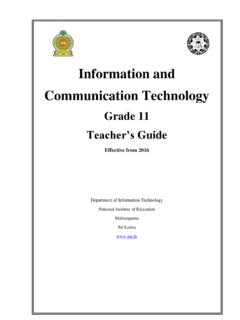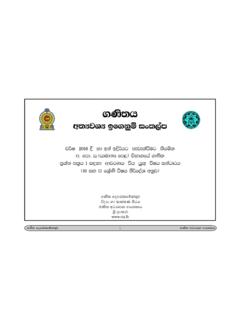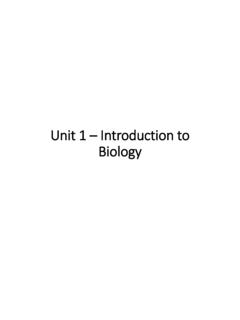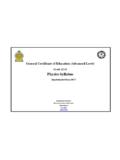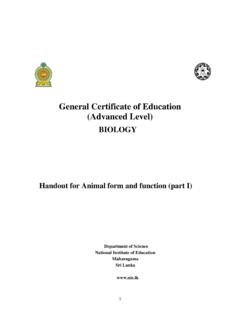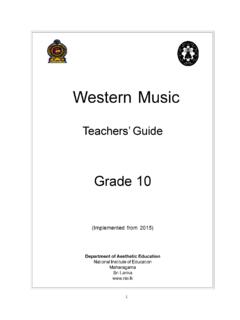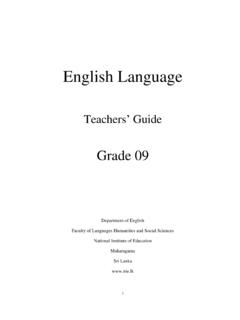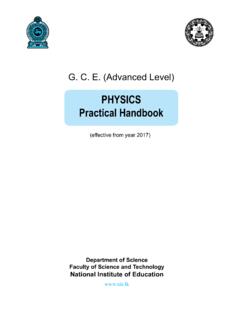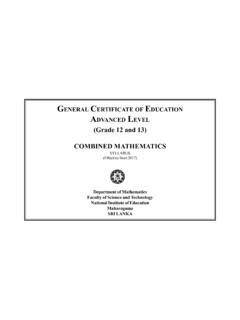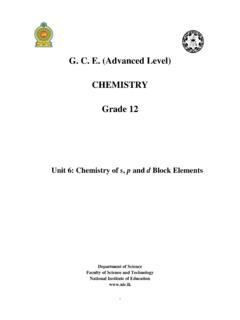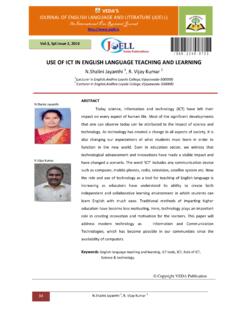Transcription of Information and Communication Technology
1 I Information and Communication Technology Grade 10. Teacher's Guide Effective from 2015. Department of Information Technology National Institute of Education Maharagama Sri Lanka ii Information and Communication Technology Grade 10. Teachers' Guide National Institute of Education ISBN. First Print Department of Information Technology National Institute of Education Maharagama iii Message from the Director General The first phase of the new competency based curriculum, with 8 years curriculum cycle was introduced to secondary education in Sri Lanka in 2007 replacing the existed content based education system with basic objective of developing the national level competencies recommended by the National Education Commission. The second phase of the curriculum cycle to be introduced to grades 6 and 10 starts from 2015.
2 For this purpose, National Institute of Education has introduced a rationalization process and developed rationalized syllabi for these grades using research based outcomes and various suggestions made by different stakeholders. In the rationalization process, vertical integration has been used to systematically develop the competency levels in all subjects from fundamentals to advanced levels using the bottom up approach. Horizontal integration is used to minimize the overlapping in the subject content and to reduce the content over loading in the subjects to produce more students friendly and implementable curricular. A new format has been introduced to the teachers' guide with the aim of providing the teachers with the required guidance in the areas of lesson planning, teaching, carrying out activities and measurement and evaluation.
3 These guidelines will help the teachers to be more productive and effective in the classroom. The new teachers' guides provide freedom to the teachers in selecting quality inputs and additional activities to develop the competencies of the students. The new teachers' guides are not loaded with subject content that is covered in the recommended textbooks. Therefore, it is essential for the teacher to use the new teachers' guides simultaneously with the relevant textbooks prepared by Education Publication Department as reference guides to be more aware of the syllabi. The basic objectives of the rationalized syllabi and the new format of teachers' guide and newly developed textbooks are to bring a shift from the teacher centered education system into a student centered and more activity based education system in order to develop the competencies and skills of the school leavers and to enable the system to produce suitable human resource to the world of work.
4 I would like to take this opportunity to thank the members of Academic Affairs Board and Council of National Institute of Education and all the resource persons who have immensely contributed in developing these new teacher guides. Director General National Institute of Education iv Message from the Deputy Director General Education from the past has been constantly changing and forging forward. In recent years, these changes have become quite rapid. Past two decades have witnessed a high surge in teaching methodologies as well as in the use of technological tools and in the field of knowledge creation. Accordingly, the National Institute of Education is in the process or taking appropriate and timely steps with regard to the education reforms of 2015.
5 It is with immense pleasure that this Teachers' Guide where the new curriculum has been planned based on a thorough study of the changes that have taken place in the global context adopted in terms of local needs based on a student-centered learning-teaching approach, is presented to you teachers who serve as the pilots of the schools system. An instructional manual of this nature is provided to you with the confidence that, you will be able to make a greater contribution using this. There is no doubt whatsoever that this Teachers' Guide will provide substantial support in the classroom teaching-learning process at the same time. Furthermore the teacher will have a better control of the classroom with a constructive approach in selecting modern resource materials and following guide lines given in this book.
6 I trust that through the careful study of this Teachers Guide provided to you, you will act with commitment in the generation of a greatly creative set of students capable of helping Sri Lanka move socially as well as economically forward. This Teachers' Guide is the outcome of the expertise and unflagging commitment of a team of subject teachers and academics in the field Education. While expressing my sincere appreciation of this task performed for the development of the education system, my heartfelt thanks go to all of you who contributed your knowledge and skills in making this document such a landmark in the field. Jayawardhana Deputy Director General Faculty of Science and Technology v Curriculum Revision Committee Guidance and and Approval Academic Affairs Board, National Institute of Education Subject Coordination Mr.
7 Maduwage Director, Department of Information Technology , National Institute of Edcuation Mr. Perera, Seniour Lecturer, Department of Information Technology , National Institute of Edcuation Panel of writers: Internal staff Mr. Perera, Seniour Lecturer, Department of Information Technology , National Institute of Edcuation Panel of writers: External Ms. Silva, ADE(Actg.), Negambo Educational Zone Mr. Kotalawala, ISA, Homagama Educational Zone. Mr. Dayarathne, ISA, Colombo Educational Zone. Ms. Jayathileke, ISA, Kalutara Educational Zone. Mr. Kalugalarachchi, ISA, Matugama Educational Zone. Ms. Sandamali, ADE, ICT Unit, Ministry of Education Ms. Amarasinghe, Kottawa Dharmapala Vidyalaya Ms. Wijesekara. Kottawa Dharmapala Vidyalaya Mr. Anura ISA, Horana Educational Zone.
8 Mr. Jayasinghe, ISA, Minuwangoda Educational Zone. Language Editing Mr. Percival, Retd. Training College Lecturer, SLEAS. vi Instructions for use of the Teacher's Guide This Teacher's Guide covers all competency levels of the Grade 10 ICT syllabus and is designed as relevant to the learning- teaching process. In addition to the competency levels and subject matter, some more related concepts and terms have also been highlighted. The objective is to provide the user with more in depth understanding of the syllabus. The guidance for leeson plans may be modified by the teacher to suit the relevant context. The assessment and evaluation guidance may also be modified according to the needs of the situation. Quality inputs mentioned in this case are specified websites and e-learnig material included in the DVD that accompanies this Teracher's Guide.
9 These are meant for the use of both teachers and students and could be integrated in their learning teaching process to their convenience. Guidance is provided for the preparation of lab-sheets and it is very important to involve students in laboratory practicals as it provides them with better understanding of the subject matter and could lead them to develop skills necessary to ensure a better place in the world of work that demands ICT applications. For laboratory practicals following items of software are recommended and they are also included in the DVD. Operating Systems a flavour of Linux Office applications a flavour of Open Office vii Information and Communication Technology Syllabus Grade 10. To be implemented from 2015. Department of Information Technology Faculty of Science and Technology National Institute of Edcuation Maharagama Sri Lanka viii 1.
10 Introduction The Information and Communication Technology sector is acknowledged worldwide as a tool that could be used to increase the productivity, efficiency and effectiveness of work. However, in Sri Lanka, the level of ICT skills of the majority of the students is not adequate to meet the current requirements of business and industry. This is mainly due to lack of opportunities for students to study ICT related subjects in the school The student should learn at school a wide variety of competencies for different needs of life in the changing world. They should have various views and different ways to continue studies and proceed to employment. Since Sri Lanka is in the early stages of introducing ICT to the lower grades, the present syllabus does not demand any ICT.
